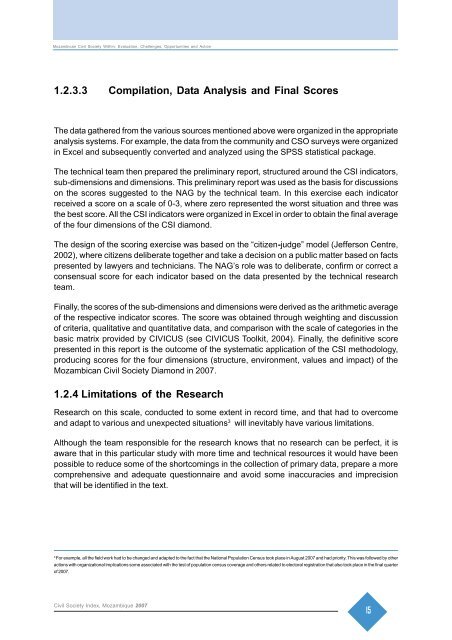Mozambican Civil Society Within: - UNICEF Mozambique - Home page
Mozambican Civil Society Within: - UNICEF Mozambique - Home page
Mozambican Civil Society Within: - UNICEF Mozambique - Home page
You also want an ePaper? Increase the reach of your titles
YUMPU automatically turns print PDFs into web optimized ePapers that Google loves.
<strong>Mozambican</strong> <strong>Civil</strong> <strong>Society</strong> <strong>Within</strong>: Evaluation, Challenges, Opportunities and Action<br />
1.2.3.3 Compilation, Data Analysis and Final Scores<br />
The data gathered from the various sources mentioned above were organized in the appropriate<br />
analysis systems. For example, the data from the community and CSO surveys were organized<br />
in Excel and subsequently converted and analyzed using the SPSS statistical package.<br />
The technical team then prepared the preliminary report, structured around the CSI indicators,<br />
sub-dimensions and dimensions. This preliminary report was used as the basis for discussions<br />
on the scores suggested to the NAG by the technical team. In this exercise each indicator<br />
received a score on a scale of 0-3, where zero represented the worst situation and three was<br />
the best score. All the CSI indicators were organized in Excel in order to obtain the final average<br />
of the four dimensions of the CSI diamond.<br />
The design of the scoring exercise was based on the “citizen-judge” model (Jefferson Centre,<br />
2002), where citizens deliberate together and take a decision on a public matter based on facts<br />
presented by lawyers and technicians. The NAG’s role was to deliberate, confirm or correct a<br />
consensual score for each indicator based on the data presented by the technical research<br />
team.<br />
Finally, the scores of the sub-dimensions and dimensions were derived as the arithmetic average<br />
of the respective indicator scores. The score was obtained through weighting and discussion<br />
of criteria, qualitative and quantitative data, and comparison with the scale of categories in the<br />
basic matrix provided by CIVICUS (see CIVICUS Toolkit, 2004). Finally, the definitive score<br />
presented in this report is the outcome of the systematic application of the CSI methodology,<br />
producing scores for the four dimensions (structure, environment, values and impact) of the<br />
<strong>Mozambican</strong> <strong>Civil</strong> <strong>Society</strong> Diamond in 2007.<br />
1.2.4 Limitations of the Research<br />
Research on this scale, conducted to some extent in record time, and that had to overcome<br />
and adapt to various and unexpected situations 3 will inevitably have various limitations.<br />
Although the team responsible for the research knows that no research can be perfect, it is<br />
aware that in this particular study with more time and technical resources it would have been<br />
possible to reduce some of the shortcomings in the collection of primary data, prepare a more<br />
comprehensive and adequate questionnaire and avoid some inaccuracies and imprecision<br />
that will be identified in the text.<br />
3<br />
For example, all the field work had to be changed and adapted to the fact that the National Population Census took place in August 2007 and had priority. This was followed by other<br />
actions with organizational implications some associated with the test of population census coverage and others related to electoral registration that also took place in the final quarter<br />
of 2007.<br />
<strong>Civil</strong> <strong>Society</strong> Index, <strong>Mozambique</strong> 2007<br />
15
















